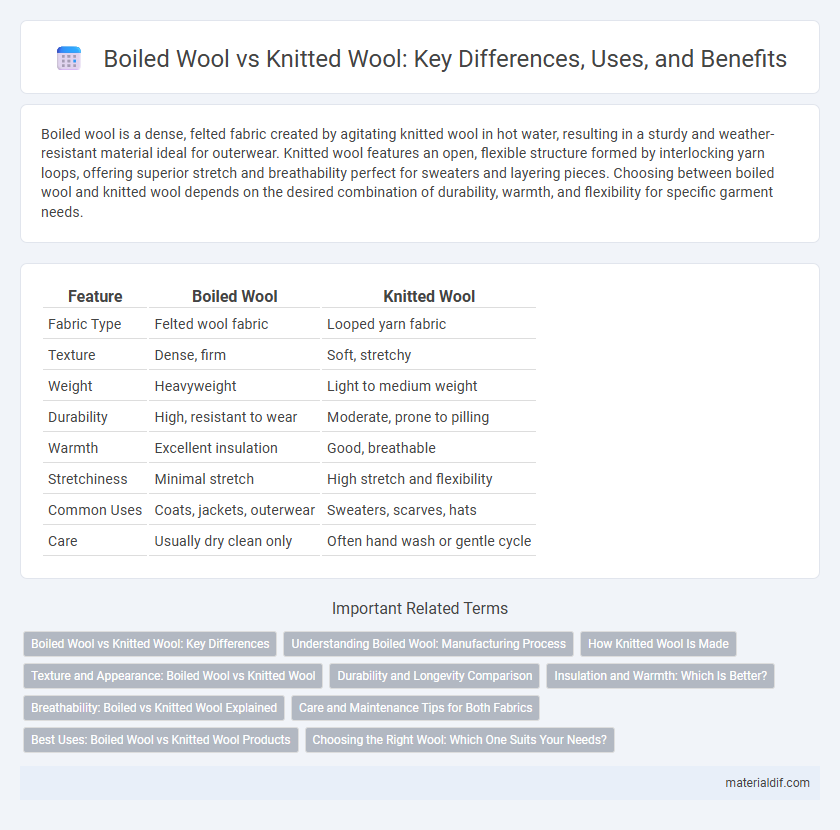Boiled wool is a dense, felted fabric created by agitating knitted wool in hot water, resulting in a sturdy and weather-resistant material ideal for outerwear. Knitted wool features an open, flexible structure formed by interlocking yarn loops, offering superior stretch and breathability perfect for sweaters and layering pieces. Choosing between boiled wool and knitted wool depends on the desired combination of durability, warmth, and flexibility for specific garment needs.
Table of Comparison
| Feature | Boiled Wool | Knitted Wool |
|---|---|---|
| Fabric Type | Felted wool fabric | Looped yarn fabric |
| Texture | Dense, firm | Soft, stretchy |
| Weight | Heavyweight | Light to medium weight |
| Durability | High, resistant to wear | Moderate, prone to pilling |
| Warmth | Excellent insulation | Good, breathable |
| Stretchiness | Minimal stretch | High stretch and flexibility |
| Common Uses | Coats, jackets, outerwear | Sweaters, scarves, hats |
| Care | Usually dry clean only | Often hand wash or gentle cycle |
Boiled Wool vs Knitted Wool: Key Differences
Boiled wool is a dense, felted fabric created by agitating knitted wool in hot water, resulting in a firm, water-resistant texture ideal for outerwear, while knitted wool is a softer, stretchier fabric made by interlocking yarn loops, providing flexibility and breathability suitable for sweaters and scarves. The key difference lies in their production methods: boiled wool undergoes a fulling process that shrinks and matts fibers tightly together, whereas knitted wool retains its looped structure, enhancing its elasticity. Boiled wool's durability and warmth make it preferable for structured garments, whereas knitted wool offers comfort and ease of movement in casual apparel.
Understanding Boiled Wool: Manufacturing Process
Boiled wool is created by repeatedly soaking, agitating, and heating knitted or woven wool fabric, causing the fibers to shrink and felt together, resulting in a dense, durable material. This felting process enhances the fabric's water resistance and warmth, distinguishing it from traditional knitted wool, which remains more flexible and porous. The manufacturing process of boiled wool involves controlled compression and heat, which tightly binds the fibers, making it ideal for outerwear and insulation.
How Knitted Wool Is Made
Knitted wool is made by looping wool yarns together using knitting needles or machines, creating a flexible and stretchy fabric that retains warmth and breathability. This process differs significantly from boiled wool, where knitted wool fabrics are felted and shrunk through hot water and agitation to produce a dense, sturdy material. The natural elasticity of knitted wool enhances comfort and allows for a wide range of garment designs, making it popular for sweaters, scarves, and hats.
Texture and Appearance: Boiled Wool vs Knitted Wool
Boiled wool features a dense, felted texture with a smooth, slightly fuzzy surface that offers warmth and wind resistance, while knitted wool displays a softer, stretchy texture with visible loops and a more flexible appearance. The compacted fibers in boiled wool create a matte finish, contrasting with the varied textures and patterns achievable in knitted wool due to its interlocked yarn loops. These differences in texture and appearance influence the suitability of boiled wool for structured garments and knitted wool for cozy, form-fitting apparel.
Durability and Longevity Comparison
Boiled wool, made by fulling and shrinking woven wool fabric, offers superior durability and resistance to wear due to its dense, felted structure. Knitted wool, characterized by its stretch and flexibility, tends to be less durable over time as the loops can stretch and lose shape, leading to potential sagging and wear. For long-lasting garments, boiled wool provides enhanced longevity, maintaining its form and strength better than knitted wool under regular use.
Insulation and Warmth: Which Is Better?
Boiled wool, created by felting knitted wool through a hot water and agitation process, offers superior insulation due to its dense, compact fibers that trap heat effectively, making it ideal for cold weather. Knitted wool provides more breathability and flexibility but is less efficient in retaining warmth compared to boiled wool, as its looser knit structure allows more air flow. For maximum insulation and warmth, boiled wool outperforms knitted wool by providing a thicker, wind-resistant barrier.
Breathability: Boiled vs Knitted Wool Explained
Boiled wool offers dense fabric with limited breathability due to its felted texture, making it ideal for insulation and wind resistance. Knitted wool features an open structure that promotes airflow, enhancing moisture management and comfort during physical activity. Choosing between boiled and knitted wool depends on the balance desired between warmth retention and breathability in outdoor or casual wear.
Care and Maintenance Tips for Both Fabrics
Boiled wool requires gentle hand washing in cold water and air drying to maintain its dense texture and prevent shrinking, while knitted wool benefits from delicate machine washing on a wool cycle or hand washing with mild detergent to preserve elasticity. Avoid wringing or twisting boiled wool, and reshape knitted wool garments while damp to retain their form. Regular brushing removes surface lint from both fabrics, and storing them folded in a cool, dry place prevents stretching and moth damage.
Best Uses: Boiled Wool vs Knitted Wool Products
Boiled wool, known for its dense, felted texture, excels in outerwear such as coats, hats, and slippers due to its durability, warmth, and water resistance. Knitted wool offers superior stretch and breathability, making it ideal for sweaters, scarves, and gloves that require flexibility and comfort. Choosing between boiled wool and knitted wool depends on the intended use, balancing structural rigidity with elasticity for optimal performance in different wool products.
Choosing the Right Wool: Which One Suits Your Needs?
Boiled wool, known for its dense, felted texture, provides superior insulation and wind resistance, making it ideal for outerwear and cold-weather accessories. Knitted wool offers greater elasticity and breathability, perfect for flexible, comfortable garments like sweaters and scarves. Assess your project's requirements for warmth, stretch, and durability to select the wool type that best suits your needs.
Boiled wool vs Knitted wool Infographic

 materialdif.com
materialdif.com